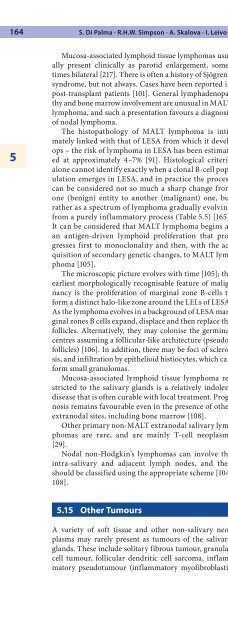Pathology of the Head and Neck
Pathology of the Head and Neck
Pathology of the Head and Neck
- No tags were found...
Create successful ePaper yourself
Turn your PDF publications into a flip-book with our unique Google optimized e-Paper software.
164 S. Di Palma · R.H.W. Simpson · A. Skalova · I. Leivo5Mucosa-associated lymphoid tissue lymphomas usuallypresent clinically as parotid enlargement, sometimesbilateral [217]. There is <strong>of</strong>ten a history <strong>of</strong> Sjögren’ssyndrome, but not always. Cases have been reported inpost-transplant patients [101]. General lymphadenopathy<strong>and</strong> bone marrow involvement are unusual in MALTlymphoma, <strong>and</strong> such a presentation favours a diagnosis<strong>of</strong> nodal lymphoma.The histopathology <strong>of</strong> MALT lymphoma is intimatelylinked with that <strong>of</strong> LESA from which it develops– <strong>the</strong> risk <strong>of</strong> lymphoma in LESA has been estimatedat approximately 4–7% [91]. Histological criteriaalone cannot identify exactly when a clonal B-cell populationemerges in LESA, <strong>and</strong> in practice <strong>the</strong> processcan be considered not so much a sharp change fromone (benign) entity to ano<strong>the</strong>r (malignant) one, butra<strong>the</strong>r as a spectrum <strong>of</strong> lymphoma gradually evolvingfrom a purely inflammatory process (Table 5.5) [165].It can be considered that MALT lymphoma begins asan antigen-driven lymphoid proliferation that progressesfirst to monoclonality <strong>and</strong> <strong>the</strong>n, with <strong>the</strong> acquisition<strong>of</strong> secondary genetic changes, to MALT lymphoma[105].The microscopic picture evolves with time [105]; <strong>the</strong>earliest morphologically recognisable feature <strong>of</strong> malignancyis <strong>the</strong> proliferation <strong>of</strong> marginal zone B-cells t<strong>of</strong>orm a distinct halo-like zone around <strong>the</strong> LELs <strong>of</strong> LESA.As <strong>the</strong> lymphoma evolves in a background <strong>of</strong> LESA marginalzones B cells exp<strong>and</strong>, displace <strong>and</strong> <strong>the</strong>n replace <strong>the</strong>follicles. Alternatively, <strong>the</strong>y may colonise <strong>the</strong> germinalcentres assuming a follicular-like architecture (pseud<strong>of</strong>ollicles)[106]. In addition, <strong>the</strong>re may be foci <strong>of</strong> sclerosis,<strong>and</strong> infiltration by epi<strong>the</strong>lioid histiocytes, which canform small granulomas.Mucosa-associated lymphoid tissue lymphoma restrictedto <strong>the</strong> salivary gl<strong>and</strong>s is a relatively indolentdisease that is <strong>of</strong>ten curable with local treatment. Prognosisremains favourable even in <strong>the</strong> presence <strong>of</strong> o<strong>the</strong>rextranodal sites, including bone marrow [108].O<strong>the</strong>r primary non-MALT extranodal salivary lymphomasare rare, <strong>and</strong> are mainly T-cell neoplasms[29].Nodal non-Hodgkin’s lymphomas can involve <strong>the</strong>intra-salivary <strong>and</strong> adjacent lymph nodes, <strong>and</strong> <strong>the</strong>yshould be classified using <strong>the</strong> appropriate scheme [104,108].5.15 O<strong>the</strong>r TumoursA variety <strong>of</strong> s<strong>of</strong>t tissue <strong>and</strong> o<strong>the</strong>r non-salivary neoplasmsmay rarely present as tumours <strong>of</strong> <strong>the</strong> salivarygl<strong>and</strong>s. These include solitary fibrous tumour, granularcell tumour, follicular dendritic cell sarcoma, inflammatorypseudotumour (inflammatory my<strong>of</strong>ibroblastictumour), primary malignant melanoma, primitive neuroectodermaltumour (PNET) <strong>and</strong> teratoma.5.16 Unclassified TumoursThe revised WHO classification defines this group asbenign or malignant tumours that cannot be placed inany <strong>of</strong> <strong>the</strong> categories [171]. This designation may be unavoidableif only a small quantity <strong>of</strong> tissue is availablefor study.References1. Albeck H, Bentzen J, Ockelmann HH, Nielsen NH, Bretlau P,Hansen HS (1993) Familial clusters <strong>of</strong> nasopharyngeal carcinoma<strong>and</strong> salivary gl<strong>and</strong> carcinomas in Greenl<strong>and</strong> natives.Cancer 72:196–2002. Alós LL, Cardesa A, Bombí JA, Mall<strong>of</strong>ré C, Cuchi A, TraserraJ (1996) Myoepi<strong>the</strong>lial tumors <strong>of</strong> salivary gl<strong>and</strong>s: a clinicopathologic,immunohistochemical <strong>and</strong> flow-cytometricstudy. Semin Diagn Pathol 13:138–1473. Altini M, Coleman H, Kienkle F (1997) Intra-vascular tumourin pleomorphic adenoma – a report <strong>of</strong> four cases. Histopathology31:55–594. Angeles-Angeles A, Caballero-Mendoza E, Tapia-Rangel B,Cortés-González R, Larriva-Sahd J (1998) Adenocarcinomagigante de células acinares de tipo quístico papilar en parótida.Rev Invest Clin 50:245–2485. Araújo VC de, Loducca SVL, Sobral APV, Kowalski AL,Soares F, Araújo NS de (2002) Salivary duct carcinoma: cytokeratin14 as a marker <strong>of</strong> in situ intraductal growth. Histopathology41:244–2496. Auclair P (1994) Tumor-associated lymphoid proliferationin <strong>the</strong> parotid gl<strong>and</strong>: a potential diagnostic pitfall. Oral SurgOral Med Oral Pathol 77:19–267. Auclair PL, Ellis GL (1996) Atypical features in salivarygl<strong>and</strong> mixed tumors: <strong>the</strong>ir relationship to malignant transformation.Mod Pathol 9:652–6578. Barbareschi M, Pecciarini L, Cangi MG, Macrì E, Rizzo A,Viale G, Doglioni C (2001) p63, a p53 homologue, is a selectivenuclear marker <strong>of</strong> myoepi<strong>the</strong>lial cells <strong>of</strong> <strong>the</strong> humanbreast. Am J Surg Pathol 25:1054–10608a. Barnes L, Eveson JW, Reichart P, Sidransky D, (eds) (2005)WHO Classification <strong>of</strong> Tumours. <strong>Pathology</strong> <strong>and</strong> Genetics.<strong>Head</strong> <strong>and</strong> <strong>Neck</strong> Tumours. Chapter 5. Salivary gl<strong>and</strong>s. IARCPress Lyon9. Barnes L, Rao U, Krause J, Contis L, Schwartz A, ScalamognaP (1994) Salivary duct carcinoma. I. A clinicopathologicevaluation <strong>and</strong> DNA image analysis <strong>of</strong> 13 cases with review<strong>of</strong> <strong>the</strong> literature. Oral Surg Oral Med Oral Pathol 78:64–7310. Batsakis JG (1979) Tumors <strong>of</strong> <strong>the</strong> head <strong>and</strong> neck: clinical <strong>and</strong>pathological considerations, 2nd edn. Williams & Wilkins,Baltimore, p 11611. Batsakis JG (1996) Sclerosing polycystic adenosis: a newlyrecognized salivary gl<strong>and</strong> lesion, a form <strong>of</strong> chronic sialadenitis.Adv Anat Pathol 3:298–30412. Batsakis JG, El-Naggar AK (1990) Sebaceous lesions <strong>of</strong> salivarygl<strong>and</strong>s <strong>and</strong> oral cavity. Ann Otol Rhinol Laryngol99:416–41813. Batsakis JG, El-Naggar AK, Luna MA (1992) Epi<strong>the</strong>lial-myoepi<strong>the</strong>lialcarcinoma <strong>of</strong> salivary gl<strong>and</strong>s. Ann Otol RhinolLaryngol 101:540–54214. Batsakis JG, Frankenthaler R (1992) Embryoma (sialoblastoma)<strong>of</strong> salivary gl<strong>and</strong>s. Ann Otol Rhinol Laryngol 101:958–960








